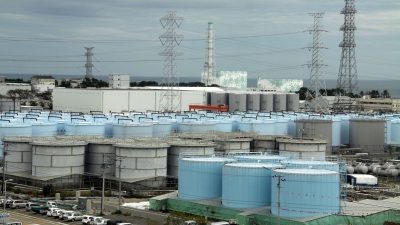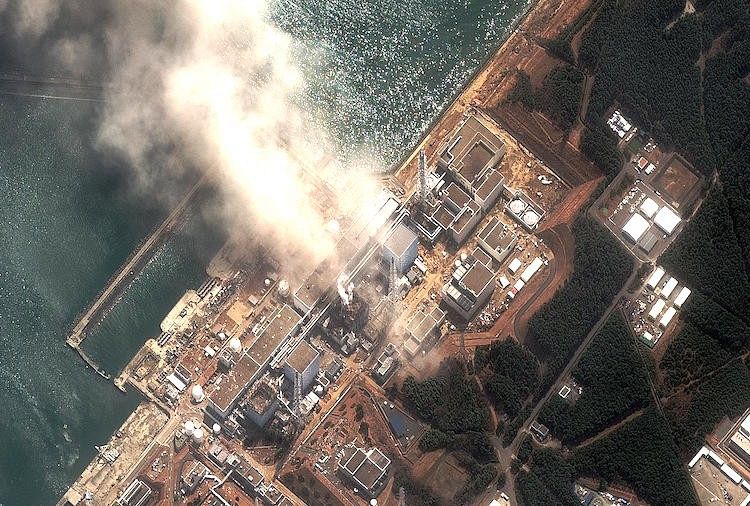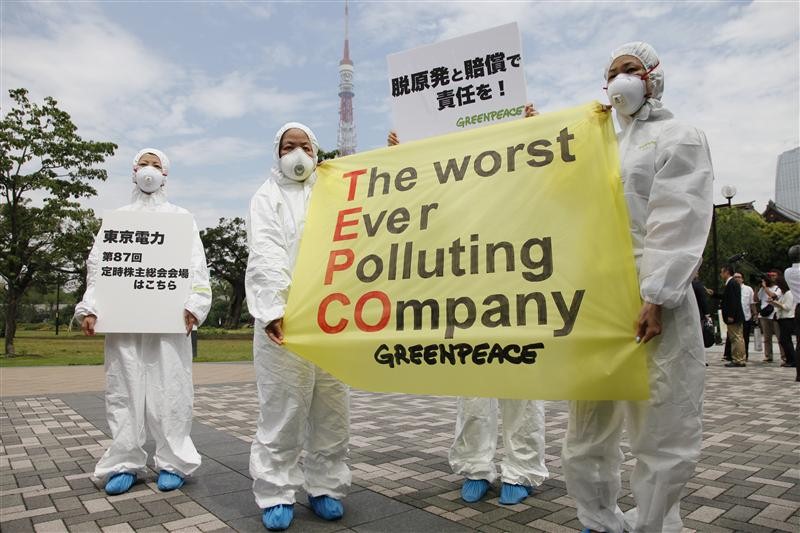Fukushima Up Close, 13 Years Later

All Global Research articles can be read in 51 languages by activating the Translate Website button below the author’s name.
To receive Global Research’s Daily Newsletter (selected articles), click here.
Click the share button above to email/forward this article to your friends and colleagues. Follow us on Instagram and Twitter and subscribe to our Telegram Channel. Feel free to repost and share widely Global Research articles.
***
The world is turning to nuclear power as a solution to global warming, but it is postulated herein that it is a huge mistake that endangers society. One nuclear meltdown causes as much damage over the long-term as a major war. Moreover, according to Dr. Paul Dorfman, chair of the Nuclear Consulting Group, former secretary to the UK Scientific Advisory Committee on Internal Radiation: “It’s important to understand that nuclear is very likely to be a significant climate casualty.”
Also, of interest, Google: “France’s Global Warming Predicament,” which discusses nuclear energy’s vulnerability in a global warming world.
Beyond Nuclear International recently published an article about the status of Fukushima as well as an exposé of how the nuclear industry gets away with responsibility for radiation-caused (1) deaths (2) chronic conditions like cancer (3) genetic deformities: A Strategy of Concealment, September 24, 2023, by Kolin Kobayashi, who is a Tokyo-born France-based anti-nuclear activist journalist also serving as president of Echo-Exchange. Kobayashi’s work was posted by CounterPunch under the title: How Agencies That Promote Nuclear Power Are Quietly Managing Its Disaster Narrative.
The following synopsis, including editorial license that adds important death details which defy the nuclear industry’s bogus claims about nuclear safety, opens closed pathways to what’s really going on.
After thirteen years, the declaration of a State of Emergency for Fukushima Daiichi Nuclear Power Plant still cannot be lifted because of many unknowns, as well as ubiquitous deadly radiation levels. The destroyed reactors are tinderboxes of highly radioactive spent fuel rods that contain more cesium-137 than eighty-five (85) Chernobyls. Cesium-137 in or near a human body erupts into a series of maladies, one after another in short order, depending upon level of exposure: (1) nausea (2) vomiting (3) diarrhea (4) bleeding (5) coma leading to death.
The spent fuel rods at the Fukushima nuclear reactor site are stored in pools of water on the top floor of compromised reactor buildings 100 feet above ground level, except for Unit 3 which completed removal of its spent fuel rods in 2019, an extremely slow, laborious process that’s highly dangerous.
Stored spent fuel rods in open pools of water are the epitome of high-risk. “If the 440 tonne vessel collapses, it could hit the storage pool next to it. If this pool is damaged, even partially, another major disaster could occur.” (Kobayashi) In that regard, there’s significant risk of collapse in the event of a strong earthquake. And Japan is one of the most earthquake prone countries in the world. “The city (Tokyo) government’s experts reckon there is a 70% chance of a magnitude 7, or higher, quake hitting the capital within the next 30 years.” (Source: Japan is Preparing for a Massive Earthquake, The Economist, August 31, 2023)
If exposed to open air, spent fuel rods erupt into a sizzling zirconium fire followed by massive radiation bursts of the most toxic material on the planet. It can upend an entire countryside and force evacuation of major cities. According to the widely recognized nuclear expert Paul Blanch: “Continual storage in spent fuel pools is the most unsafe thing you could do.” Paul Blanch, registered professional engineer, US Navy Reactor Operator & Instructor with 55 years of experience with nuclear engineering and regulatory agencies, is widely recognized as one of America’s leading experts on nuclear power.
Satellite image shows damage at Fukushima Nuclear Power Plant (via ecowatch.com).
Fukushima Daichi Nuclear Power Plant will remain a high-risk explosive scenario for decades ahead. After all, a program for future decommissioning is unclear and overall radiation guesstimates are formidable. All the structures where decommissioning will take place are highly radioactive and as such nearly impossible for the dangers to worker exposure.
TEPCO (Tokyo Electric Power Company) does not yet know the true extent of damage nor the complete dispersion of corium (molten magma from melted nuclear fuel rods in the core of the reactors). Although engineers believe they’ve located the corium in all three crippled units. For example, when unit 1 was surveyed by a robot, images showed many parts of the concrete foundation supporting the pressure vessel severely damaged by intense heat from corium. Corium, which is the product of the meltdown of fuel rods in the core of the reactor, is so hot that “corium lava can melt upwards of 30cm (12 inches) of concrete in 1 hour.” (Source: The Most Dangerous (Man-Made) Lava Flow, Wired, April 10, 2013)
Furthermore, on specific point: Researchers at Argonne National Laboratory created corium at 2000°C in an experiment. The experiment demonstrated that “cooling with water may not be sufficient” to halt damaging aspects of corium to concrete. According to the Argonne experiment: “One thing to remember — much of the melting of concrete during a meltdown occurs within minutes to hours, so keeping the core cool is vital for stopping the corium from breaching that containment vessel.”
In the case of Fukushima, TEPCO claims the corium did not breach the outer wall of the containment vessels, “although there is a healthy debate about this,” Ibid. Still, an open question remains. The crippled reactors are so hot with radiation that it’s nearly impossible to fully know what’s happening. Dangers of corium: “Long after the meltdown, the lava constituting the corium will remain highly dangerously radioactive for decades-to-centuries.” (Wired)
Regarding the decision to start releasing radioactive water from storage tanks at Fukushima, which water accumulates daily for purposes of keeping the hot stuff from igniting into an indeterminate fireball, the decision to release was approved by the International Atomic Energy Agency: “The IAEA does not have the scientific authority to make reference to the ecological impact of this water discharge, nor has it carried out such a long-term assessment. It is more of a political decision than a scientific one.” (Kobayashi)
Radiation Risks to Society
According to the World Nuclear Association, there were no fatalities due to radiation exposure at Fukushima. And as recently as 2021, Forbes magazine reported No one Died From Radiation At Fukushima: IAEA Boss. It is believed this is a lie and part of a massive coverup.
Greenpeace activists protest outside the Tokyo Electric Power Company (TEPCO) shareholder’s meeting held at The Prince Park Tower in Tokyo. They hold a banner which reads: “TEPCO: The worst Ever Polluting Company.” TEPCO is the operator of the crisis-stricken Fukushima Nuclear Power Plant which has been emitting radion since it was struck by an earthquake and tsunami on March 2011. The activists also raised a banner reading “No more nuclear” in Japanese, asking TEPCO to disengage from the nuclear industry.
According to Green Cross (founded in 1993 by Mikhail Gorbachev, who repeatedly spoke out about interrelated threats humanity and our Earth confront from nuclear arms, chemical weapons, unsustainable development, and the human-induced decimation of the planet’s ecology): “Approximately 32 million people in Japan are affected by the radioactive fallout from the nuclear disaster in Fukushima… This includes people who were exposed to radiation and other stress factors resulting from the accident and who are consequently at potential risk from both long and short-term consequences… As with the Chernobyl nuclear accident, which impacted 10 million people, Japan is expected to see increased cancer risk and neuropsychological long-term health consequences.”
With nuclear radiation, the damage to humans shows up years later as cancer and/or deformity of newborns second/third generation. For example, only recently, the truth has come to surface about Chernobyl-related deaths, child deformities, and cancer 30+ years after the event. For example:
- A BBC Future Planet article d/d July 25, 2019, The True Toll of the Chernobyl Disaster: “According to the official, internationally recognized death toll, just 31 people died as an immediate result of Chernobyl while the UN estimates that only 50 deaths can be directly attributed to the disaster. In 2005, it predicted a further 4,000 might eventually die as a result of the radiation exposure… Brown’s research, however, suggests Chernobyl has cast a far longer shadow.”
- “The number of deaths in subsequent decades remains in dispute. The lowest estimates are 4,000; others 90,000 and up to 200,000.” (Source: Janata Weekly: Cuba and the Children of Chernobyl, May 7, 2023)
- According to an article in USA Today d/d February 24, 2022, What Happened at Chernobyl? What to Know About Nuclear Disaster: “At least 28 people were killed by the disaster, but thousands more have died from cancer as a result of radiation that spread after the explosion and fire. The effects of radiation on the environment and humans is still being studied.”
According to Chernobyl Children International, 6,000 newborns are born every year in Ukraine with congenital heart defects called “Chernobyl Heart.”
Fukushima Report: The stress-related effects of Fukushima evacuation and subsequent relocation are also a concern. The evacuation involved a total of over 400,000 individuals, 160,000 of them from within 20km of Fukushima. The number of deaths from the nuclear disaster attributed to stress, fatigue and the hardship of living as evacuees is estimated to be around 1,700 so far. (Source; Fukushima Daiichi Power Plant Disaster: How Many People Were Affected? 2015 Report, Reliefweb, March 9, 2015.
The Fukushima Report was prepared under the direction of Prof. Jonathan M. Samet, Director of the Institute for Global Health at the University of Southern California (USC), as a Green Cross initiative. Green Cross International: GCI is an independent non-profit and nongovernmental organization founded in 1993 by Nobel Peace Laureate Mikhail Gorbachev.
Over time, Japan is expected to see increased cancer risks and neuropsychological long-term health consequences. “The lives of approximately 42 million people have been permanently affected by radioactive contamination caused by the accidents in the Chernobyl and Fukushima Daiichi nuclear power plants. Continued exposure to low-level radiation, entering the human body on a daily basis through food intake, is of particular consequence,” Ibid.
Fukushima Deaths
The cocksure pro-nuclear crowd has trumpeted Fukushima as an example of Mother Nature taking lives because of an earthquake and tsunami; whereas the power plant accident proves nuclear power can withstand the worst without unnecessary death and illness. According to nuclear industry reports, all the deaths (16,000) were the fault of Mother Nature, not radiation.
But people in the streets and on the ground in Japan tell a different story about the risks of radiation. They talk about illnesses and death. TEPCO itself has reported few radiation illnesses and no radiation-caused deaths but what if it’s not their responsibility in the first instance, as layers of contractors and subcontractors employ workers to cleanup the toxic mess. If “subcontractor workers die” from radiation exposure, so what? It’s not TEPCO’s responsibility to report worker deaths of subcontractors, and the subcontractors are not motivated to report deaths, which are not reported.
According to credible sources in Japan, death is in the air, to wit: “The ashes of half a dozen unidentified laborers ended up at a Buddhist temple in this town just north of the crippled Fukushima nuclear plant. Some of the dead men had no papers, others left no emergency contacts. Their names could not be confirmed, and no family members had been tracked down to claim their remains. They were simply labeled ‘decontamination troops’ — unknown soldiers in Japan’s massive cleanup campaign to make Fukushima livable again five years after radiation poisoned the fertile countryside… Hideaki Kinoshita, a Buddhist monk… keeps the unidentified laborers’ ashes at his temple, in wooden boxes and wrapped in white cloth.” (Source: Mari Yamaguchi, Fukushima‘Decontamination Troops’ Often Exploited, Shunned, AP & ABC News, Minamisoma, Japan, Mar 10, 2016)
“The men were among the 26,000 workers — many in their 50s and 60s from the margins of society with no special skills or close family ties — tasked with removing the contaminated topsoil and stuffing it into tens of thousands of black bags lining the fields and roads. They wipe off roofs, clean out gutters and chop down trees in a seemingly endless routine… Coming from across Japan to do a dirty, risky and undesirable job, the workers make up the very bottom of the nation’s murky, caste-like subcontractor system long criticized for labor violations,” Ibid.
The following is part of an interview with Katsutaka Idogawa, former mayor of Futaba, Fukushima Prefecture. (Source: Fukushima Disaster: Tokyo Hides Truth as Children Die, Become Ill from Radiation – Ex-Mayor, RT, April 21, 2014):
SS (question): The United Nations report on the radiation fallout from Fukushima says no radiation-related deaths or acute diseases have been observed among the workers and general public exposed – so it’s not that dangerous after all? Or is there not enough information available to make proper assessments? What do you think?
Katslutaka Idogawa’s response: “This report is completely false. The report was made by a representative of Japan – Professor Hayano. Representing Japan, he lied to the whole world. When I was mayor, I knew many people who died from a heart attack, and then there were many people in Fukushima who died suddenly, even among young people. It’s a real shame that the authorities hide the truth from the whole world, from the UN. We need to admit that actually many people are dying. We are not allowed to say that, but TEPCO employees also are dying. But they keep mum about it.”
Mako Oshidori, interviewed in Germany, director of Free Press Corporation/Japan, investigated several unreported worker deaths, and interviewed a former nurse who quit TEPCO: “I would like to talk about my interview of a nurse who used to work at the Fukushima Daiichi Nuclear Power Plant (NPP) after the accident… He quit his job with TEPCO in 2013, and that’s when I interviewed him… As of now, there are multiple NPP workers that have died, but only the ones who died on the job are reported publicly. Some of them have died suddenly while off work, for instance, during the weekend or in their sleep, but none of their deaths are reported.” (Oshidori)
“Not only that, but they are also not included in the worker death count. For example, there are some workers who quit the job after a lot of radiation exposure… and end up dying a month later, but none of these deaths are either reported, or included in the death toll. This is the reality of the NPP workers.” (Oshidori)
During her interview, Ms. Oshidori commented, “There is one thing that really surprised me here in Europe. It’s the fact that people here think Japan is a very democratic and free country.”
Mako’s full interview “The Hidden Truth about Fukushima.”
Alas, two hundred U.S. sailors of the USS Ronald Reagan filed a lawsuit against TEPCO, claiming that they experienced leukemia, ulcers, gall bladder removals, brain cancer, brain tumors, testicular cancer, dysfunctional uterine bleeding, thyroid illness, stomach ailments and other complaints extremely unusual in such young adults. One sailor died from radiation complications. Among the plaintiffs was a sailor who was pregnant during the mission. Her baby was born with multiple genetic mutations.
The sailors that filed the suit participated in “Operation Tomodachi,” providing humanitarian relief after the March 11th, 2011 Fukushima disaster based upon assurances that radiation levels were okay. But that was a lie.
Ultimately, and unsurprisingly, the 9th U.S. Circuit Court of Appeals rejected the sailors’ appeal.
In summation, the final word is left to Kolin Kobaryashi: “The international nuclear lobby, which represents only a minority, has the influence and money to dominate the world’s population with immense power and has now united the world’s minority nuclear community into one big galaxy. Many of the citizens who have experienced the world’s three most serious civil nuclear accidents have clearly realized that nuclear energy is too dangerous. These citizens are so divided and conflicted that they feel like a helpless minority.”
“Former prime ministers Junichiro Koizumi and Naoto Kan called on the European Union on Thursday to pursue a path toward zero nuclear power, with the bloc planning to designate it as a form of “green” energy in achieving net-zero emissions by midcentury.” (Source: Ex-Prime Ministers Koizumi and Kan Demand EU Choose Zero Nuclear Power Path, The Japan Times, Jan. 27, 2022)
“Five former Japanese prime ministers issued declarations that Japan should break with nuclear power generation on March 11, the 10th anniversary of the Great East Japan Earthquake and tsunami that triggered a nuclear disaster in Fukushima Prefecture… Former prime ministers Morihiro Hosokawa, Tomiichi Murayama, Junichiro Koizumi, Yukio Hatoyama and Naoto Kan signed and released their declarations during the conference. Among them, Koizumi, Hatoyama and Kan took to the podium and shook hands… In his declaration titled ‘Don’t hold back on reversing a mistake: A zero-carbon emission society can be achieved without nuclear power plants,’ Koizumi said, ‘When it comes to the nuclear power plant issue, there is no ruling party or opposition party. Nuclear power plants expose many people’s lives to danger, bring financial ruin, and cause impossible-to-solve nuclear waste problems. We have no choice but to abolish them.” (Source: 5 ex-Japan PMs Call for Country to End Nuclear Power Use on Fukushima 10th Anniversary, The Mainichi, March 12, 2021)
Japan PM Kishida Orders New Nuclear Power Plant Construction, Nikkei Asia, August 24, 2022.
*
Note to readers: Please click the share button above. Follow us on Instagram and Twitter and subscribe to our Telegram Channel. Feel free to repost and share widely Global Research articles.
Robert Hunziker is a journalist from Los Angeles.
Featured image is from Countercurrents



